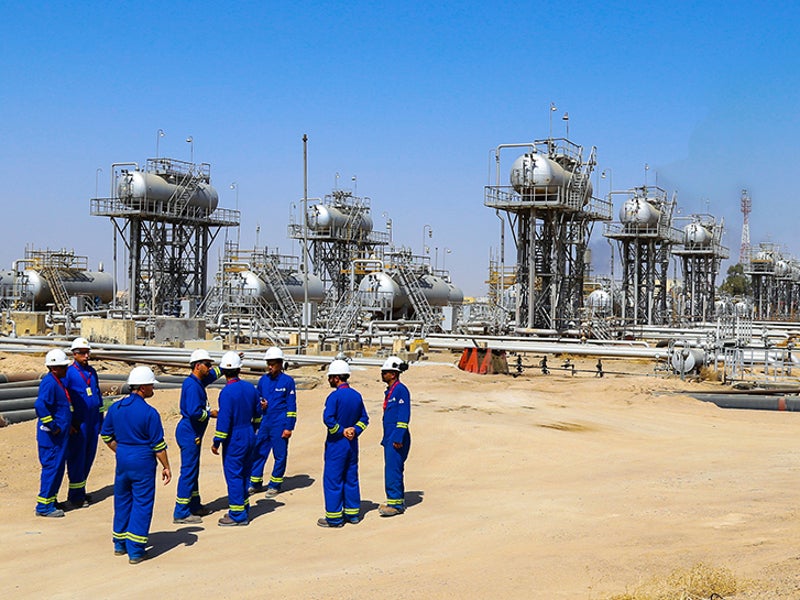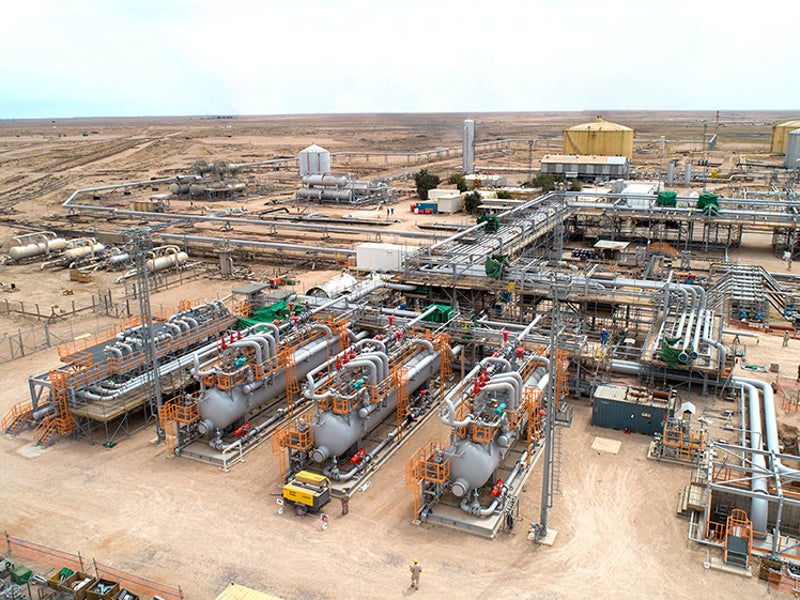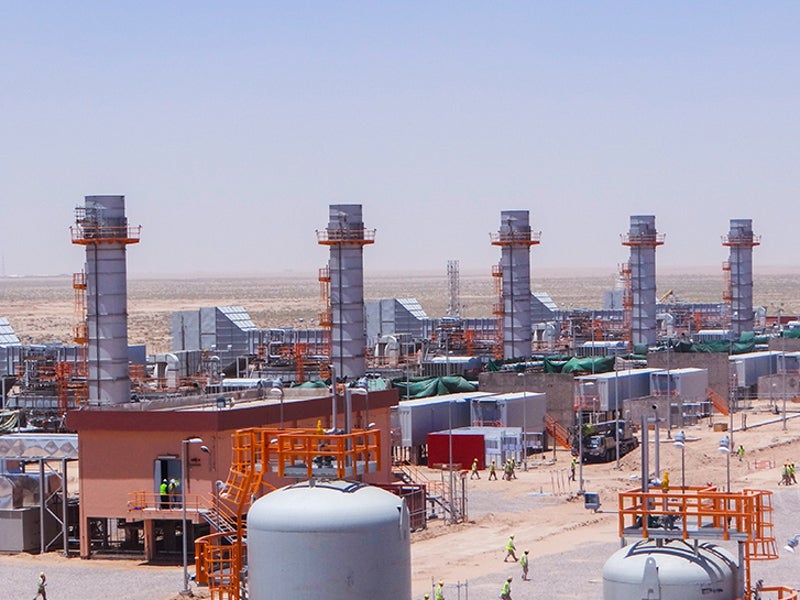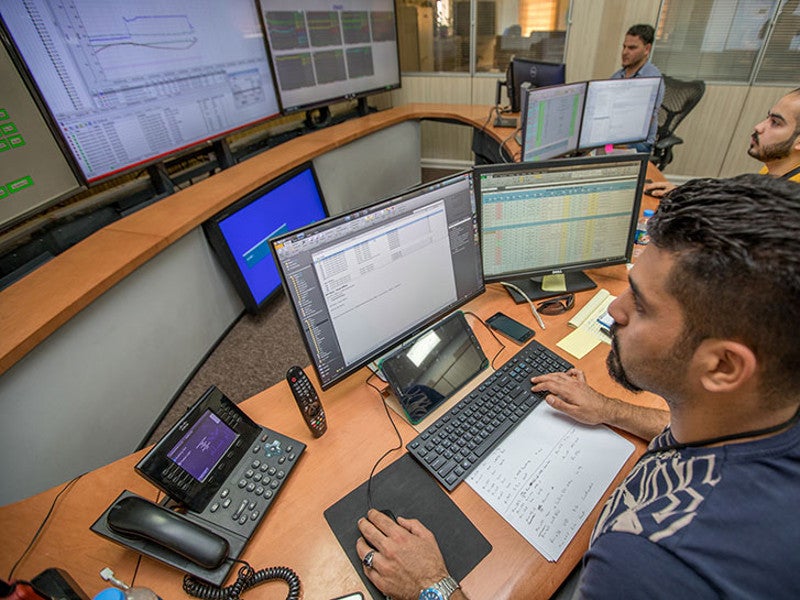Rumaila oil field lies close to the Kuwait border, approximately 50km west of Basra in southern Iraq. At 1.5 million barrels of oil a day (Mbopd) capacity, it is the world’s third biggest producing field and delivers approximately one-third of Iraq’s total oil supply.
The giant onshore field, which has been producing since 1954, is still left with an estimated 17 billion barrels of recoverable oil reserves.
The Rumaila field is operated by Rumaila Operating Organisation (ROO), an unincorporated joint venture between the state-owned Basra Oil Company (BOC) (formerly South Oil Company of Iraq), BP, PetroChina, and the State Oil Marketing Organization (SOMO) of Iraq.
Since ROO became the new operator in 2010, the field has produced more than four billion barrels of oil, with daily output level increased by 40% as of June 2019. Development options are available to raise the output beyond 2Mbopd level, subject to increase in international oil prices and withdrawal of forced production cuts by the Iraqi Government.
The ROO partnership has invested more than $12bn on Rumaila operations by 2019, to upgrade the field infrastructure and ensure consistently high production levels.
The mature old field has also been transformed into one of the most modern oil fields in Iraq that features application of most advanced oil recovery technologies and operates as a digital oil field.
Rumaila field discovery and reservoir details
Discovered by the Iraq Petroleum Company in 1953, the Rumaila oil field spans a vast area of 1,600km² by extending frm north to south for approximately 80km and from west to east for 20km.
The main reservoir structures of the field are Zubair (Main Pay) formation, Upper Shale reservoir, and the Mishrif reservoir, which lies in the northern part of Rumaila.
Situated up to 4km-deep beneath the surface, the Rumaila reservoirs comprise sandstone and carbonate formations of Cretaceous age.
Rumaila field development background
Commercial oil production at the Rumaila field was commenced towards the end of 1954 and grew steadily to peak at 1.75Mbopd in May 1979.
The persisting Iraq-Iran conflict, followed by the Iraq War, caused gradual decline in the production rates by an average 5% a year, to as low as 1.06Mbod in June 2010, due to inadequate investment.
ROO was formed as a partnership between the South Oil Company of Iraq (now Basra Oil Company), the State Oil Marketing Organization, BP, and PetroChina in 2010, under a 20-year technical services contract (TSC) developed by the Ministry of Oil in 2009 to revive the field and raise its production.
BP had carried out technical evaluation of the Rumaila field with Ministry of Oil, Iraq, between 2003 and 2006.
After ROO assumed operatorship in June 2010, the field’s production capacity was increased from 1.06Mbopd to 1.2Mbopd by December 2010.
The field’s output was subsequently raised and sustained at consistently high production levels of more than 1.3Mbopd in the next three years, which led to the extension of the original TSC tenure by additional five years until 2034, in September 2014.
Field expansion by ROO
The ROO consortium has drilled more than 300 new wells at Rumaila, apart from maximising the efficiency of 276 pre-existing wells and reactivating some of the previously ceased wells.
The new production wells now account for more than 40% of the field’s current total oil output.
The new operator’s strategy has been to optimise the performance of the existing brownfield installations including degassing stations, cluster pump stations, and water treatment plant. It has also commissioned the field’s captive power plant and installed a digital oil field facility at Rumaila.
Rumaila’s production reached its 30 year-high of 1.5Mbopd in June 2019.
Rumaila field infrastructure facilities
The Rumaila oil field is currently developed with more than 700 wells, out of which approximately 550 are producer wells and 150 are injector wells. Majority of Rumaila wells are producing from the Zubair (Main Pay) formation.
The Rumaila oil field operations also include with 14 degassing facilities and ten cluster pump stations.
Approximately two million barrels of fluid a day is treated at Rumaila, out of which up to 500,000 barrels of water is removed and disposed of.
ROO commissioned three new dehydrator and desalter production facilities and installed new free water knock out vessels at two of the degassing stations in 2018, to boost production capacity by 124,000 bpd, while ensuring high oil quality.
A 235MW gas-fired power plant was commissioned in March 2018 to supply electricity for the field operation as well as the Iraq national grid. The power plant consists of five gas turbine generator units that run on gas sourced from the field’s reservoirs.
The giant field operation has also been digitised with the installation of 2,000 digital sensors across the wells and facilities to provide real-time data, allowing the operation’s headquarters to observe and guide the production performance.
A major expansion of the digital oil field infrastructure at Rumaila was completed in December 2018.
The water treatment facility at Qarmat Ali was expanded to boost water injection capacity in 2017, while a new headquarters, supply base, and a training academy have also been established under ROO’s operatorship.
Oil recovery techniques at Rumaila oil field
The Rumaila oil field utilises a total of 300 electric submersible pumps (ESPs) for selected wells to increase oil recovery, while production from more than 150 wells has been increased through the use of nitrogen lift and perforation technologies.
Horizontal drilling technique has been adopted to drill a total of 12 high angle wells (HAW) at Rumaila, including four in the northern part of the field and eight in the southern part.
The first HAW was drilled in August 2013, which has demonstrated that HAWs, with maximum reservoir contact, can produce up to three times more oil than conventional vertical wells.
Contractors involved
Amec Foster Wheeler (now Wood Group) was awarded a three-year framework agreement to conduct conceptual and pre-front end engineering design (FEED) studies to support plans for sustained production growth at Rumaila in June 2016.
Petrofac was awarded a £318m ($535.8m) project management services contract for the Rumaila field in May 2014, while China Petroleum Engineering & Construction Corporation (CPECC) received a £252m ($425m) contract to provide engineering, procurement, construction, and commissioning (EPCC) services for the captive power plant.
Petrofac was also previously awarded a £56m ($90m) contract to provide inspection, maintenance, and repair services at the field in June 2011.
The drilling contractors engaged for the Rumaila field development since 2010 include Schlumberger, Iraqi Drilling Company, Weatherford International, Daqing Drilling, and the Turkish Petroleum International Company (TPIC).
Centrilift (now Baker Hughes) and Alkhorayef Petroleum were contracted for the supply and installation of electrical submersible pumps (ESPs), while Cameron was contracted for the supply of associated trees and wellheads.
WorleyParsons received a £62m ($100m) contract for the conceptual design, FEED, and integrated project management team (IPMT) services for production expansion at the field in February 2011.
GE Oil and Gas supplied integrated packages of pumps, gas engines, and other associated equipment for water re-injection operations, under a £25m ($40m) contract awarded in September 2011.
Mott MacDonald provided engineering, design, and construction management services for the Rumaila operating base with accommodation and office facilities for 300 people, under a contract awarded in April 2010.






